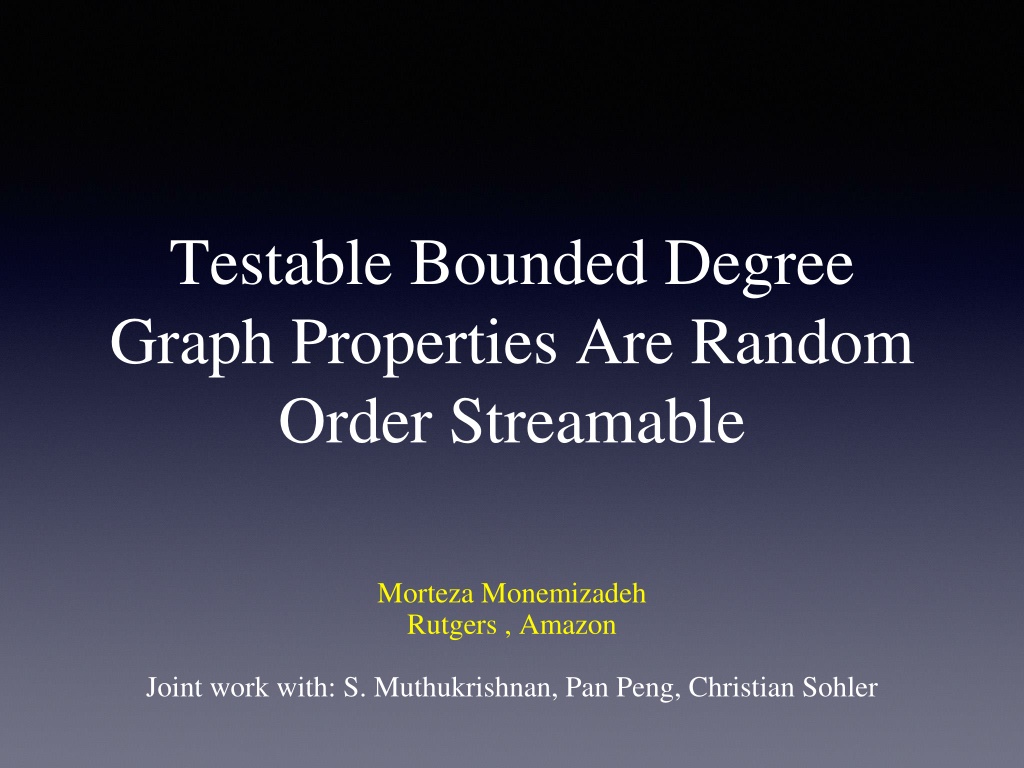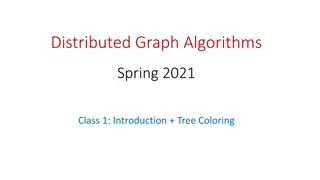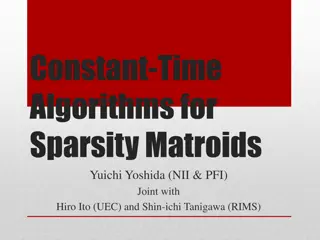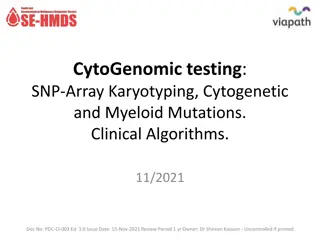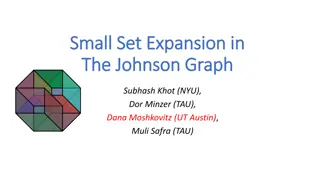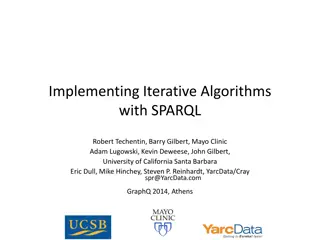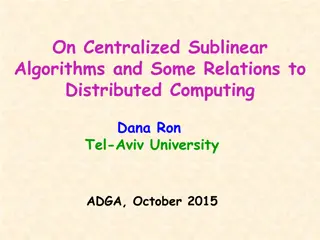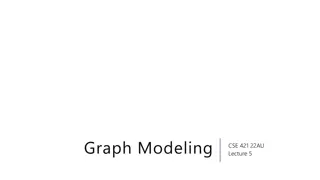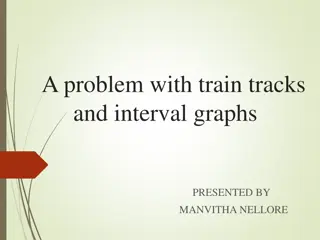Graph Property Testing and Algorithms Overview
Explore testable bounded degree graph properties, sparse graphs, d-bounded degree graphs, hyperfinite graphs, arboricity, maximum matching algorithms, and sublinear time approximation algorithms in graph data streams. Learn about various graph models and properties with examples, showcasing the important concepts and algorithms in graph theory research.
Download Presentation

Please find below an Image/Link to download the presentation.
The content on the website is provided AS IS for your information and personal use only. It may not be sold, licensed, or shared on other websites without obtaining consent from the author. Download presentation by click this link. If you encounter any issues during the download, it is possible that the publisher has removed the file from their server.
E N D
Presentation Transcript
Testable Bounded Degree Graph Properties Are Random Order Streamable Morteza Monemizadeh Rutgers , Amazon Joint work with: S. Muthukrishnan, Pan Peng, Christian Sohler
Sparse Graphs Given a graph G(V,E) where n=|V| and m = |E| = O(n).
d-Bounded Degree Graphs Given a graph G(V,E) whose maximum degree d is constant, where n=|V| and 0 m = |E| nd.
(,k,d)-Hyperfinite G(V,E) G is ( ,k,d)-hyperfinite graph if we remove a set of at most dn edges of G s.t. the remaining graph has connected components of size at most k.
Arboricity Is a way to quantify the density of a graph G(V,E). c = maxU {|E(U)|/(|U|-1)} where U is a subset of V. G can be partitioned into at most c forests. Planar graphs have arboricity c = 3.
Maximum Matching Given a graph G(V,E), find a set of pairwise non-adjacent of maximum size, i.e., no two edges share a common edge.
Maximum Matching 30-years-old algorithm due to Micali and Vazirani with running time m n. Greedy algorithm returns maximal matching (2- approximation of maximum matching).
Big Data Models for Graphs Data Streams: Graph Streams Property Testing: Testing Graph Properties. Sublinear Time Approximation Algorithms
Streaming Model 3 2 1 7 4 5 6 8 Stream S =(2,4) , (3,6), (2,7), (4,6), ...
Graph Streams Adverserial or Random Order Model O(c)-approximate the size of matching in c- bounded arboricity graphs using O(clog2 n) space in adversarial model. O(polylog n)-approximate the size of matching in general graphs using O(polylog n) space in random order model.
Graph Streams Adverserial or Random Order Model In general, it is not clear which graph problems can be solved with much smaller space in the random order stream than in the adversary order stream.
Graph Streams Semi-Streaming Model: O(n polylog(n)) space Sparse Graphs: m=O(n) O(polylog(n)) or even better O(1) space
d-Bounded Graph Given a graph G(V,E) whose maximum degree d is constant, where n=|V| and 0 m = |E| nd.
Adjacency List Model Query access to the adjacency list of G: For any vertex v and index i one can query the i-th neighbor (if exists) of v in constant time.
Property Testing A property n for d-bounded n-vertex graphs is testable with query complexity q, if for every ?, d and n, there exists an algorithm that performs q(n,d, ?) queries to the adjacency list of the graph and with probability 2/3 Accepts any n-vertex d-bounded graph G satisfying n, Rejects any n-vertex d-bounded graph G that is ?-far from satisfying n, If q(d, ?) is independent of n, we call n constant query testable.
Property Testing Theorem: Any d-bounded graph property that is constant-query testable in the adjacency list model can be tested in random order streaming model with constant space.
Examples Adversary Order Model: Testing k-edge connectivity, k-vertex connectivity and cycle-freeness of d-bounded degree graphs needs ? Dynamic graph stream algorithms in o(n) space. Huang and Peng, ICALP 2016.
Examples Random Order Model: k-edge connectivity, k-vertex connectivity and cycle- freeness of d-bounded degree graphs are testable in constant space in the random order stream model, since they are constant-query testable in the adjacency list model. Property testing in bounded degree graphs. Oded Goldreich and Dana Ron, Algorithmica 2002
Property Testing Proof (sketch): Every constant query property tester Samples a constant number of vertices Explores the k-discs of these vertices? Makes deterministic decisions based on the explored graph.
k-disc The local neighborhood of depth k of a vertex is the subgraph induced by all vertices of distance at most k. v A k-disc has at most dk+1 vertices and dk+2 edges.
Constant-Time Approximation Algorithms
Adjacency List Model Query access to the adjacency list of G: For any vertex v index i one can query the the i-th neighbor (if exists) of v in constant time.
(x,y)-Approximation We call a value t an (x,y)-approximation for the problem P, if for any instance I, we have OPT(I) t x OPT(I)+y For a minimization optimization problem P and an instance I, we let OPT(I) denote the value of some optimal solution of I.
O(1)-time Approximation Algorithm Theorem: There exists an algorithm that uses constant space in the random order model, and with probability 2/3, (1, n)-approximates the size of a maximal matching. Based on Locality Lemma due to Nguyen and Onak, FOCS 08
O(1)-time Approximation Algorithm Similar result holds for minimum vertex cover, maximum matching, the number of connected components.
O(1)-time Approximation Algorithm Theorem: There exists an algorithm that uses constant space in the random order model, and with probability 2/3, (1 )-approximates the size of a maximal matching.
O(1)-time Approximation Algorithm Greedy Matching e1e2 e3e4 Stream : ei Current Matching M
O(1)-time Approximation Algorithm Greedy Matching e1e2 e3e4 Stream : ei Is ei in M? Current Matching M
O(1)-time Approximation Algorithm .4 .3 .4 .7 .5 v .6 .6 .2
k-disc Primitive Given a random order stream S of edges of an underlying d-bounded degree graph G(V,E). Sample the full k-disc of a vertex v (almost) uniformly at random.
2-Pass Algorithm First Pass: Sample a set S of (dk+2)! vertices and collect their observed k-discs in S. In expectation, there exists at least one vertex in S whose full k-disc is observed.
2-Pass Algorithm Second Pass: Find the degree of vertices in (partially explored) k-discs of the vertices in S. Report the k-disc of a vertex in S that is fully explored.
Partial Order Hd,k={ 1, , x} : The set of all k-disc isomorphism types. i j: j is root-preserving isomorphic to some subgraph of i. j i
Ordering Order all the k-disc types 1, , x such that if i j, then i j. i j
Ordering Order all the k-disc types 1, , x such that if i j, then i j. i j G(j): All the indices i, except j itself, such that i j.
Frequency Vector F(G,d) Vi: The set of vertices with k-disc isomorphic to i , Vi={v V: disck,G(v) i} i j 10010 10 2324 8273 9744 |Vi| fi=|Vi|/n
Marginal Probability Let S be a random order Stream. Let v be a vertex with k-disc isomorphic to i. Marginal Probability: The probability ( j| i) that the observed k-disc of v in S is disck(v,S) j for any j such that i j. e e e e j i Stream S: , e , , e , , e,
1-Pass Algorithm Preprocssing: Sample a set T of O(2(dk+2)! / 2) vertices.
1-Pass Algorithm Preprocssing: Sample a set T of O(2(dk+2)! / 2) vertices. Streaming: For each vertex v T: Collect the observed k-disc disck(v,S) from the stream S. Let Hv be disck(v,S).
1-Pass Algorithm Postprocessing: Let H= v T Hv .
1-Pass Algorithm Postprocessing: Let H= v T Hv . For i =1 to x where x=|F(G,d)|
1-Pass Algorithm Postprocessing: Let H= v T Hv . For i =1 to x where x=|F(G,d)| Yi=|{v T: disck,H(v) i}|/|T|
1-Pass Algorithm Postprocessing: Let H= v T Hv . For i =1 to x where x=|F(G,d)| Yi=|{v T: disck,H(v) i}|/|T| Xi=(Yi- j G(i) Xj ( i| j)) -1( i| i) G(i): All the indices j, except i itself, such that j i.
1-Pass Algorithm Postprocessing: Let H= v T Hv . For i =1 to x where x=|F(G,d)| Yi=|{v T: disck,H(v) i}|/|T| Xi=(Yi- j G(i) Xj ( i| j)) -1( i| i) Return X1, , Xx. G(i): All the indices j, except i itself, such that j i.
